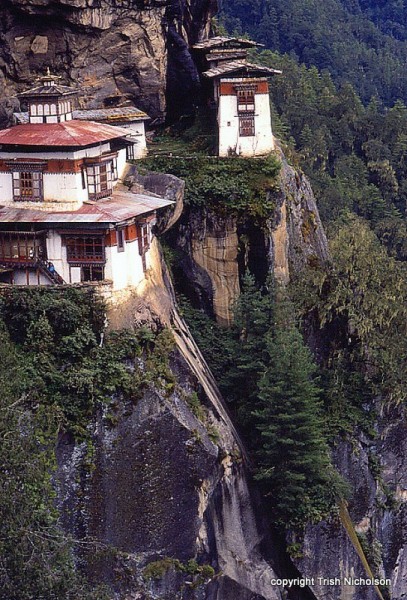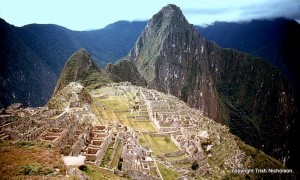 Yes, there really is a ‘restaurant at the end of the universe’.
Yes, there really is a ‘restaurant at the end of the universe’.
I’ve always found high places conducive to creative thought, so here is some fun I’ve been having with my photo album.
Since I took this photograph on Mount Chacaltaya, Bolivia, in 1981 the ski resort has been completed and extended. At 17,500 ft, it has the highest ski-lift in the world. I claim no mountaineering skill in getting there: kamikaze taxi drivers take you up the narrow, winding road to within a few hundred feet of the top. And the restaurant was right on the summit.
 The road – and the original tow-lift, powered by a car engine – was built in the 1930s when Chacaltaya still had a glacier. In recent years, most of the snow has melted, so not only is skiing restricted, but the lack of snow now threatens the water supply to La Paz.
The road – and the original tow-lift, powered by a car engine – was built in the 1930s when Chacaltaya still had a glacier. In recent years, most of the snow has melted, so not only is skiing restricted, but the lack of snow now threatens the water supply to La Paz.
But thirty years ago, I sat on the summit in a state of altitude-euphoria, writing elation in my journal.
To rise above worldly concerns in search of Nirvana may be why Padmasambhava – an eighth century Buddhist missionary and Bodhisattva – chose to establish the first monastery on this ledge on a 3,000 ft cliff-face in the Paro district of Bhutan.

The present building, Taktsang Monastery, dates mostly from the seventeenth century. And if this seems impressive, there is another monastery built on a rock promontory above this one, aptly named Sang-Tog Peri – Temple of Heaven.
No taxis bring you here: it is a hard, hazardous trek along steep paths scratched into the mountain side that make you cling on to your prayer beads. It inspired my illustrated e-book travelogue: Journey in Bhutan: Himalayan Trek in the Kingdom of the Thunder Dragon.

The Inca in South America liked to build on high places too, but every photographer has taken this shot of Machu Picchu, so let’s turn around and look in the opposite direction –
 – at the Sugar-Loaf that sticks up in the Urubamba Valley like a decayed but stubborn tooth. The thin white line around the base is the railway from Cuzco. The Urubamba was a sacred river to the Incas; at lower altitudes, its broad, fertile flood plain was the centre of maize production at the heart of the Inca Empire.
– at the Sugar-Loaf that sticks up in the Urubamba Valley like a decayed but stubborn tooth. The thin white line around the base is the railway from Cuzco. The Urubamba was a sacred river to the Incas; at lower altitudes, its broad, fertile flood plain was the centre of maize production at the heart of the Inca Empire.
But the Urubamba’s origins are high-up amid the drama of the Andes.

I can’t remember where I was standing – more probably, lying on the ground – to take this photograph, but I doubt if I had the nerve to stay there for long.

And what could be more creative than the decor of this yak-skin ger on the high plateau of Outer Mongolia?
But the creativity I seek is not in what has already been built, however spectacular; what matters is not ideas that come into me, but the spaces between them that draw inspiration out of me.
Mostly, I associate high places with desolate and enchanting landscapes, like this plain at the base of the Shishipangma mountain range in southern Tibet. A group of us camped and walked here in preparation for a trek along East Rongbuk Glacier, on the flanks of Chomulungma (Everest).

It’s an interesting word – ‘desolate’. Its root is ‘solus’, alone, but it has come to mean abandoned, dreary, hopeless. These represent the negative aspects, the fear of being alone, but there is also a positive side to ‘aloneness’: the opportunity to look inside ourselves, search for our inner narrative, find our own story without the incessant chatter of the world around us. My times in desolate places are precious inspiration to write.
If I could fly, I would, but the real high places are for the birds.

This bird was soaring over the Bolivian Andes, not far from Lake Cotapachi where Collcas Incaicas, the ingenious Inca grain stores, still remain. Could it be a condor? – I’m not sure.
 If you are interested in travel and photography, you can check out my illustrated e-book travelogue, Journey in Bhutan: Himalayan Trek in the Kingdom of the Thunder Dragon.
If you are interested in travel and photography, you can check out my illustrated e-book travelogue, Journey in Bhutan: Himalayan Trek in the Kingdom of the Thunder Dragon.
 Or, if you prefer somewhere hot and steamy to stimulate your creativity, you could go Inside The Crocodile: The Papua New Guinea Journals
Or, if you prefer somewhere hot and steamy to stimulate your creativity, you could go Inside The Crocodile: The Papua New Guinea Journals
 Trish Nicholson’s latest book, A Biography of Story, A Brief History of Humanity, travels through time as well as around the world. From our foraging ancestors to the digital age, this cultural history reveals the power of stories in the comedy and tragedy of human affairs. Storytellers from every corner of the world guide us through a tapestry of history and literature, reconnecting us with the past and with stories old and new. You can read more about A Biography of Story here.
Trish Nicholson’s latest book, A Biography of Story, A Brief History of Humanity, travels through time as well as around the world. From our foraging ancestors to the digital age, this cultural history reveals the power of stories in the comedy and tragedy of human affairs. Storytellers from every corner of the world guide us through a tapestry of history and literature, reconnecting us with the past and with stories old and new. You can read more about A Biography of Story here.

Lovely words, all join together to make a wonderful story. I like looking at the photos on my iPhone as I can enlarge them and look at details and the bird is huge, I do think it looks like a Condor. You have done so many exciting things in your life, I hope you experience many more.
Thank you, Anne. It always takes longer to post a photo-essay but it’s worth it when someone says they’ve enjoyed it. I’ve never used an iPhone, can’t imagine trying to read on something so small, but if you can enlarge things, that must help. I would like it to be a Condor, perhaps a bird expert will happen by and confirm. Thanks again for your support.
Your posts and photos are so inspiring, Trish. I love them. I can picture you in these places absorbing the silence, or the atmosphere and culture, and it is wonderful that you share the experiences with us. Your last picture of the bird, prompts me to ask whether you can get BBC IPlayer? There is a series on BBC1 at the moment called Earthflight – a documentary showing the migration and breeding etc. of all manor of birds – the filming and photography of birds in flight is totally stunning.
Oh dear, for ‘manor’ read ‘manner’ – my only excuse is that I am weary 🙂
Haha I know the weary feeling that brings forth the typos, but the BBC has many mansions, and many manors too, to be sure 🙂
I’ll see if it can find that programme through the internet (I don’t have a television). I’m so glad you enjoy the photos, the sharing enables me to relive it all. A couple of years ago I had a solo photographic exhibition here called ‘Other places: Other faces’, quite a few people visited but this is a small town and it was a financial disaster – on a small scale. I packed everything away and thought that was it, nothing else to do with all my pics – until I started my website this year. The idea of posting photo-essays, a term the lovely artist @tonyjohansen used for my Barcelona post, has grown on me and I love it. Most of my travel has been alone, so the photographs were taken specifically to share afterwards.Your appreciation means a great deal to me, thank you.
Wow! Beautiful, amazing, breathtaking – excellent.
Hello, Anne, lovely to see you here. Wow! for your comments, thank you. At one time I thought there was nothing I could do with all my photos – some taken a good few years ago – but I’m enjoying them in my writing, they spark off lots of ideas. And it’s wonderful to remember these moments, too.